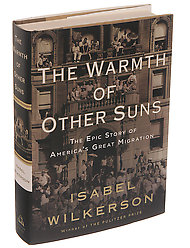The Warmth of Other Suns
(Random House, 2010, 620 pp.)
By Isabel Wilkerson
The Warmth of Other Suns is a book of epic proportions, one that will grab you on page one and never let you go.
In this Pulitzer Prize winning book written by a first time novelist, Isabel Wilkerson recreates the true story of the Great Migration of approximately six million black American citizens who journeyed from the Jim Crow South from 1915 through the 1960’s in search of a better life. Before this exodus began, more than 90% of people of color in this country lived in the South. By the time this mass movement ended, roughly half of America’s blacks resided in the North and West changing the landscape of such cities as New York, Philadelphia, Detroit, Chicago, and Los Angeles forever.
Before selecting the three individuals whose lives are chronicled in her book, Wilkerson interviewed twelve hundred individuals over a ten-year period before finally choosing three people to tell their stories and to be representatives of those six million. They were: Ida Mae Gladney, who migrated from Mississippi to Chicago in 1937; George Starling, who fled to Harlem from Florida in 1954; and Dr. Robert Foster, who left Louisiana in 1953 to practice medicine in Los Angeles. Each left for different reasons, but all were in search of the same things: freedom from the laws of Jim Crow, better opportunities for work, and better living conditions. All three individuals were interviewed for hundreds of hours and Ms. Wilkerson even reenacted all or parts of each of their migration routes to get a feel for what it must have been like.
We learn that once they arrived in their newly found homes, these migrants from the American South built new lives around the people and churches they knew from back home. They sought to instill within their children the religious and family values of their upbringing and to keep their ancestral history alive through the stories they recounted. Although it contains 620 pages, The Warmth of Other Suns is an enjoyable read. The three central characters are just ordinary people with stories similar to those in our families who left Louisiana for California during the height of segregation.
Ironically, after the Great Migration drew to a close in the 1960s, blacks began to move back to the South. This “reverse migration” has escalated since 1990 prompted by job opportunities and integration. Southern cities, such as Atlanta and Houston are now more integrated than their northern counterparts. The South, from which blacks fled 50 years ago in search of freedom, now appears to be the new promised land.
This is a book I highly recommend. If you read only one book this year, this is the one to read.
Lolita Villavasso Cherrie




i will be sharing this content with my friends for sure.http://www.notebookasus.net